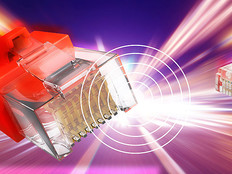GSA: Agencies Need to Get Ahead of Major Network Transition
Many projects and contracts in the federal government take years to come to fruition, but the General Services Administration is warning all agencies to get ahead of one now: the next major network technology transition.
Although agencies won’t need to move to the GSA’s Enterprise Infrastructure Solutions (EIS) contract — a $50 billion, 15-year telecommunications infrastructure vehicle — until 2020, the agency is urging federal departments to start planning for the transition now.
The EIS will provide mission-critical telecommunications infrastructure and will replace the government’s Networx, WITS3 and Local Telecommunications Services contracts. It will also be the vehicle through which agencies will take advantage of next-generation network technology for the foreseeable future. The EIS is expected to extend until 2031 and technology will continually be updated and refreshed under the vehicle.
Amando Gavino, director of the GSA’s office of network services, recently laid out the stake for agencies, the benefits of EIS, and what the shifting telecom landscape means for the federal government. In a June 30 GSA blog post, he also said that “agencies need to have a sense of urgency, focusing continuously on preparing for their complete transition until finished.”
Agency Priorities in the Networking Shift
Gavino noted that on June 22 the GSA joined more than 200 representatives from across government and industry to discuss what they needed from EIS, how agencies can find opportunities as they make transitions and how they will meet aggressive transition challenges.
In the blog post, Gavino noted that every federal agency is affected by the transition, including more than 150 agencies and 60 Native American Tribal organizations. Gavino also provided context for what the transition will mean for agencies — and what lies ahead.
“The EIS program holds opportunities for agencies, including modernizing, securing and transforming agency infrastructure,” Gavino said. “Think transformation as a key goal, rather than simply transition to the new acquisition vehicle. This means approaching EIS transition as an opportunity to transform agency telecom operations and add mission value.”
As agencies prepare for the switch to EIS, Gavino discussed key agency priorities that came up at the meeting, which include the need to complete transition before the current contracts expire in 2020. Agencies also want to use EIS to increase bandwidth, meet their cybersecurity requirements, focus on network modernization, achieve short-and long-term savings, pay only for what they use and improve performance at a lower cost.
Additionally, agencies are driving demand, not the EIS acquisition vehicle, Gavino said. “For example, due to local area networks increasingly connected to wide-area telecommunications networks over Ethernet interfaces (that time-division multiplexing interfaces were challenged to provide), demand drove Ethernet transport to be a mandatory service,” Gavino said.
Next Steps in the Transition
Soon, the federal government will put in motion the process for moving to EIS, as agencies must submit their transition plans in October. Additionally, as FCW reports: “GSA officials have said they plan to award the massive EIS contract in October, and for months, Gavino has been urging agencies to start planning how they will move their network services to EIS.”
Gavino said that to make “a successful transition, each agency needs to make an accurate inventory and strong senior leadership commitment.” The inventory will include everything from traditional, long distance telecommunication services to fully redundant, mission-critical, secure virtual private networking.
The EIS transition will be a massive undertaking, since more than 7 million inventory items across 90 regional and eight Networx contracts need to be moved, Gavino noted. All current federal government telecom inventory must be moved to EIS before the end of May 2020.
Agencies need to “engage with GSA early, get the agency contracting officer on board early and put agency governance in place,” Gavino said.
In terms of industry’s needs, Gavino said that EIS is designed to “deliver tomorrow’s technology today and GSA encourages industry to work with government on ways to make that happen.” He also said that industry vendors and partners need to prepare for “the anticipated tsunami” of EIS-related task orders and purchases.









